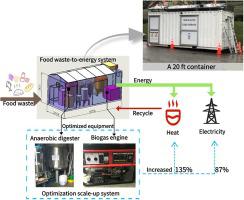当前位置:
X-MOL 学术
›
Energy Convers. Manag.
›
论文详情
Our official English website, www.x-mol.net, welcomes your feedback! (Note: you will need to create a separate account there.)
Assessment and optimization of a decentralized food-waste-to-energy system with anaerobic digestion and CHP for energy utilization
Energy Conversion and Management ( IF 10.4 ) Pub Date : 2021-01-01 , DOI: 10.1016/j.enconman.2020.113654 Jingxin Zhang , Danning Gu , Jiaqi Chen , Yiliang He , Yanjun Dai , Kai-Chee Loh , Yen Wah Tong
Energy Conversion and Management ( IF 10.4 ) Pub Date : 2021-01-01 , DOI: 10.1016/j.enconman.2020.113654 Jingxin Zhang , Danning Gu , Jiaqi Chen , Yiliang He , Yanjun Dai , Kai-Chee Loh , Yen Wah Tong

|
Abstract Biogas derived from the decentralized anaerobic digestion (AD) of food waste may be used to generate electrical and thermal energy for nearby residents through combined heat and power generation technology. A mobile food-waste-to-energy system in conjunction with an anaerobic digester and biogas engine was developed for food waste (FW) treatment and energy output. The scale-up was simulated to explore the methane yield and energy flow at different ambient temperatures of 0 °C, 10 °C, 20 °C, 30 °C and different feedstock of 200 kg, 500 kg FW. Accordingly, the results demonstrated that the installed system with a 1 m3 digester had a methane yield of 0.55L CH4 /g VS when the feedstock load was 30 kg FW/d and the Organic Load Rate (OLR) was 5.4 g VS /L, while the thermal and electrical efficiencies of this system were 31% and 16%, respectively. The corresponding exhaust gas of the thermal energy from the biogas combustion was recovered by a heat exchanger in order to keep the digester at mesophilic conditions. The simulations carried out on the scale-up systems under loads of 200 kg FW/d and 500 kg FW/d achieved a thermal energy balance at different ambient temperatures of 0 °C, 10 °C, 20 °C and 30 °C. Improvements were proposed in the optimized system by optimizing pre-treatment facilities as well as the AD reactor, biogas engine and heat exchanger. The net thermal and electrical energy output of the optimized system at 500 kg FW/d were 175.93kWh and 163.90kWh, respectively. The energy generated by the FW-to-energy system illustrated by the Sankey diagrams depicts that was enough for operation without the need of extra heat and a power supply, moreover, the surplus energy may be utilized for its neighboring communities. In addition, the optimized system under the same OLR were increased by 87% and 135%, regards the thermal and electrical energy outputs, respectively in comparison with the current system.
中文翻译:

具有厌氧消化和热电联产能源利用的分散式餐厨垃圾转化能源系统的评估和优化
摘要 餐厨垃圾分散式厌氧消化(AD)产生的沼气可通过热电联产技术为附近居民提供电能和热能。与厌氧消化器和沼气发动机相结合的移动食物垃圾转化为能源系统被开发用于食物垃圾 (FW) 处理和能量输出。模拟放大以探索不同环境温度 0 °C、10 °C、20 °C、30 °C 和不同原料 200 kg、500 kg FW 下的甲烷产量和能量流。因此,结果表明,当原料负荷为 30 kg FW/d 且有机负荷率 (OLR) 为 5.4 g VS /L 时,安装有 1 m3 消化器的系统的甲烷产量为 0.55L CH4 /g VS,而该系统的热效率和电效率分别为 31% 和 16%,分别。来自沼气燃烧的热能的相应废气通过热交换器回收,以保持消化器处于中温条件。在 200 kg FW/d 和 500 kg FW/d 负载下对放大系统进行的模拟在 0 °C、10 °C、20 °C 和 30 °C 的不同环境温度下实现了热能平衡。通过优化预处理设施以及AD反应器、沼气发动机和换热器,对优化系统提出了改进建议。优化后的系统在 500 kg FW/d 时的净热能和电能输出分别为 175.93kWh 和 163.90kWh。Sankey 图表说明的 FW-to-energy 系统产生的能量足以运行,而无需额外的热量和电源,此外,剩余的能源可用于其邻近社区。此外,优化后的系统在相同OLR下的热能和电能输出与现有系统相比分别提高了87%和135%。
更新日期:2021-01-01
中文翻译:

具有厌氧消化和热电联产能源利用的分散式餐厨垃圾转化能源系统的评估和优化
摘要 餐厨垃圾分散式厌氧消化(AD)产生的沼气可通过热电联产技术为附近居民提供电能和热能。与厌氧消化器和沼气发动机相结合的移动食物垃圾转化为能源系统被开发用于食物垃圾 (FW) 处理和能量输出。模拟放大以探索不同环境温度 0 °C、10 °C、20 °C、30 °C 和不同原料 200 kg、500 kg FW 下的甲烷产量和能量流。因此,结果表明,当原料负荷为 30 kg FW/d 且有机负荷率 (OLR) 为 5.4 g VS /L 时,安装有 1 m3 消化器的系统的甲烷产量为 0.55L CH4 /g VS,而该系统的热效率和电效率分别为 31% 和 16%,分别。来自沼气燃烧的热能的相应废气通过热交换器回收,以保持消化器处于中温条件。在 200 kg FW/d 和 500 kg FW/d 负载下对放大系统进行的模拟在 0 °C、10 °C、20 °C 和 30 °C 的不同环境温度下实现了热能平衡。通过优化预处理设施以及AD反应器、沼气发动机和换热器,对优化系统提出了改进建议。优化后的系统在 500 kg FW/d 时的净热能和电能输出分别为 175.93kWh 和 163.90kWh。Sankey 图表说明的 FW-to-energy 系统产生的能量足以运行,而无需额外的热量和电源,此外,剩余的能源可用于其邻近社区。此外,优化后的系统在相同OLR下的热能和电能输出与现有系统相比分别提高了87%和135%。



























 京公网安备 11010802027423号
京公网安备 11010802027423号